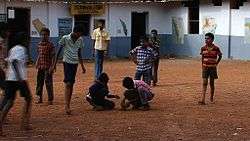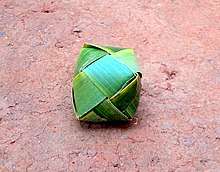Seven stones
Seven stones (also known by various other names) is a game from the Indian subcontinent involving a ball and a pile of flat stones, generally played between two teams in a large outdoor area. It is played today in villages.
 A game of Dabba Kali in Kerala | |
| Setup time | less than a minute |
|---|---|
| Playing time | 3 minutes |
| Random chance | Low |
| Skill(s) required | Running, Observation, Speed, Strength, Throwing and concentration |
History
Seven Stones, one of the most ancient games of the Indian subcontinent whose history dates back to the Bhagwata Purana, a Hindu religious text that is claimed to be written 5000 years ago, which mentions Lord Krishna playing the game with his friends.[1] This traditional sport has been played for the last 5 millennia. It is believed to have been originated in the southern parts of the Indian subcontinent. It was one of the most popular outdoor sports in India and Pakistan in the 1990s but it is now almost extinct with very few people playing the game. It often boasts of being the more aggressive version of dodgeball.
Gameplay
A member of one team (the seekers) throws a ball at a pile of stones to knock them over. The seekers then try to restore the pile of stones while staying safe from the opposing team's (the hitters’) throws. The hitters' objective is to hit the seekers with the ball before they can reconstruct the stone pile. If the ball touches a seeker, that seeker is out and the team the seeker came from continues, without the seeker. A seeker can always safeguard themselves by touching an opposite team member before the ball hits the seeker.
Additional rules
- The throwing seeker cannot come too close to the piled-up stones while attempting to knock them over. They have to do so from behind a line marked on the ground.
- If the person trying to knock down the pile cannot do it in three tries, they are considered out.
- In any of the three tries, if the thrower's ball does not knock down the pile and is caught by an opponent after the first bounce then the thrower is out.
- Each team contains equal number of players.
- Piles of flat stones contain 7 or 5 stones.
- Hitters cannot run with the ball to hit the seekers.
- The seeker, after restoring the pile of stones, says the game's name to announce the reconstruction of the pile of stones.
Alternative names

In other parts of India, the same game is known several other names:
- Lagori (Karnataka)
- Lingoj (Telangana)
- Lingorcha, Lagori, Seven Tilo (Maharashtra)
- Pitthu, Pitthhu, Pitto, Pittu (Haryana, Punjab, Chandigarh, Uttarakhand, northern Rajasthan and West Bengal)
- Sitoliya (Rajasthan, Bihar, Madhya Pradesh)
- Satodiyu (Gujarat)
- Bam Pitto, pittu (Bihar)
- Yedu penkulata, Yedu rallu, dikori or pittu (Andhra Pradesh)
- Palli Patti (Karimnagar)
- Dabba kali (Kerala, played using a ball made of coconut leaves"olapanthu")[2]
- Ezhu kallu (Tamil Nadu).[3]
- Garmaan,Garam, Minto (Kashmir)
Similar to India, the game is identified differently in various countries, but the spirit of the sport remains the same.
- Haft Sang (Iran)
- Sat Chara (Bangladesh)
- Pitho Garam, Pitthu Garam, Pitthu Gol Garam,[4] Pittu Garam,[5] Pittu Gol Garam[4] (Pakistan)
- Cantracon (Afghanistan)
Modern day
Not very long ago, kids all around the country would come together on a field to play from a plethora of outdoor games. While football and cricket were the most commonly played games, ancient and traditional Indian were also played like Kabaddi, Kho-Kho, and Gilli Danda.[1]
As time passed by, most of these traditional games began to fade away and very few remained. Kabaddi, for example, became a global phenomenon after being pushed with the Pro Kabaddi League. A game that no kid talked about 7 years ago, is now being enthusiastically watched and played by almost every child of this generation. Fortunately, Kabaddi is not the only traditional sport who gained international popularity. Lagori, which was played a lot by the youth back in the day, has also begun to make its way to the international circuit.[6]
Today, Lagori is played by at least 30 nations across the world. The game has gradually gained a considerable amount of global prominence. However, India is the epicentre of the development of the game on with a bigger platform and a wide outreach to contemporary audience. The Indian Lagori Premier League that was held in November 2017 had gathered great momentum across the nation which was organised by the Amateur Lagori Federation of India.[7] They have also made efforts to push the game to several states of India as well as in other countries, playing a pivotal role in popularising the game. The second Lagori World Cup (first being played in 2015) is soon going to take place later this year, several nations including Indian, Bhutan Hong Kong, Brazil, Turket, Sri Lanka, Bangladesh, and Nepal will go face to face.[8]
The rules have not changed that much over the years, however there have been some changes brought in the way the game is being played. The following fundamentals were laid down by the International Lagori Foundation: Each team would have 12 players, with only 6 players on the court for every set. One set lasts for 3 minutes followed by a half minute break in between sets. One match has typically 3 sets and the team scoring maximum points wins. Other than that, the rules are basically the same for all leagues. Having said that, the game has definitely come a long way from what it was. From a dusty open field to an indoor synthetic turf, from a pile of stones lying around in the field to 7 circular fibre discs made for the game, and from an old tennis ball to a softball specifically tailored for the game.[9]
Despite the game almost being forgotten and becoming extinct in the past few decades, the inaugural World Cup help in 2015 was a huge success paired with the Indian Lagori Premiere League (ILPL) catering to a wide audience in the country, it seems as though Lagori is going through its revival phase. Hopefully, like Kabaddi was successfully revived and is now on every modern kids’ minds, Lagori can emulate the same and achieve similar success in the nation and across the globe.
In popular media
- In the grand season finale of TVF Triplings, a popular Indian mini internet series made by TVF (The Viral Fever), a game of SPL (Sitoliya Pitto Lagori) acts as the glue that brings together a group of estranged siblings.[10]
References
- "Pithoo – The game of seven stones". Urban Vaastu | Best Urban Development Magazine. Retrieved 31 August 2019.
- Cohen, Noam. "When Knowledge Isn’t Written, Does It Still Count?" The New York Times. 7 August 2011. Retrieved on 22 September 2011.
- Seven stones (ஏழு கல்லு)
- "Pitthu Gol Garam". www.dentisty.org. 12 July 2018. Retrieved 4 June 2020.
… the players loudly say “PITTU GOL GARAM” …
- Shahid, Dr Khwaja Ali (24 November 2013). "Game over?". DAWN.COM. Retrieved 4 June 2020.
- "Taking You Back To the 90s: Do You Remember Playing Lagori?". Playo. 24 August 2017. Retrieved 31 August 2019.
- Paranjpe, Shailendra (26 January 2015). "Now, a premier league to popularise Lagori". DNA India. Retrieved 31 August 2019.
- Sanjiv, Deepthi SanjivDeepthi; Jun 27, Bangalore Mirror Bureau | Updated; 2017; Ist, 04:00. "Lagori's global push". Bangalore Mirror. Retrieved 31 August 2019.CS1 maint: numeric names: authors list (link)
- Bennur, Shankar (15 April 2015). "Lagori league formed to popularise the traditional sport in State". The Hindu. ISSN 0971-751X. Retrieved 31 August 2019.
- "Season finale - Season 1 episode 5 - TVF Triplings with Tata Tiago". http://tvfplay.com. TVF - The Viral Fever media Labs. Retrieved 13 October 2016. External link in
|website=(help)